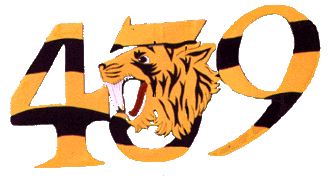|
History
of
 Squadron Squadron
  
Chapter
VII
The Advance to the Rhine
February
- March 1945
On 2 February only one operation was attempted; it deserves mention as a "gremlin" masterpiece. Eight aircraft were detailed for a rail cutting job, but
"everything seemed to go haywire from the time the
boys pressed teats".
First of all one Typhoon caught fire momentarily as it started up, so the spare aircraft taxied out. Then, as the first Tiffie seemed to be all right, the pilot started up again only to have one bomb drop off as he moved to take off position. As Blue leader started down the runway one of his bombs also
tumbled off, due to defective mechanism. The pilot carried his one remaining bomb across to enemy territory and jettisoned it.
While waiting to have Blue leader's dud missile removed from the runway, another aircraft overheated and had to switch off. Eventually three of Blue section got into the air, but one pilot
discovered an oil leak which forced him to jettison his bombs and turned back with his two section mates. Red section also got airborne with three aircraft, one of which also developed an oil leak and had to return. Only S/L Beatty and F/L Shaver were able
to complete the mission, claiming a possible cut in the line south of
Dulmen.
|
Intentionally
left blank
|
Intentionally
left blank
|
The sky cleared at midday of the 3rd and three rail jobs were completed without gremlin
interference.(1) Three cuts were blown in lines near Munster and Borken; a locomotive and one freight car were damaged. Then a cold drizzle put a damper on flying for two days, leaving the pilots with little to do but playing cards, read, write, enjoy the tempting snack sessions, and speculate about the significance of troop movements through
Eindhoven.
(1) For rail cutting 1000 lb. bombs with 11 second delay fuses were now used. Normally a section of four aircraft was assigned to each target, although occasionally the old eight plane formation was used.
So many convoys of trucks, armoured cars and tanks had
passed by the airfield that the roads were almost ruined. Rumours of an Army push to the north were confirmed on the 6th when heavy artillery fire could be heard in preparation for the Canadian Army's offencive against the Reichwald at the northern end of the Siegfried
Line.(2)
(2) The troop concentration area around Arnhem and Nijmegen was closed to all aircraft up to 16,000 feet; violation would be subject to intense anti aircraft fire.
|
|
Coincident with this increased ground activity was a stepping up of the rail interdiction campaign. On the 6th No.439 rapped in five attacks, and shared in the compliments which G/C Nesbitt received from 2nd TAF Headquarters on the good day's work. Although there was (naturally) considerable cloud, the pilots' met. reports struck a different note 10/10ths Allied aircraft over the tactical area! At one period of the day No.439 had twelve of its Typhoons in the air at the same time on three different missions.
Activities were concentrated on the railways converging on Wesel, the enemy's escape route across the Rheine. On the first operation three cuts were blown in the rails north west of Wesel; on the second two more craters were blasted in the line east of the city, and the same line was cut in two more places by the third sortie. Farther north another railroad near Borken was also cut by two bomb craters, and finally the Coesfeld Burgstein line was severed by two direct hits, to make the day's total five rails cut with eleven craters. In addition to this a warehouse by a railroad siding was damaged by a bomb dropped by F/O Hugh Fraser. The blast blew out one side of the building and set it on fire. And F/L Johnny Carr's section severely damaged two locomotives to round out an excellent day.
  
Copyright
©1998-2016 Michael T. Melnick. All rights reserved
the
unofficial homepage of  Tiger
Squadron Tiger
Squadron
.
.
|
|